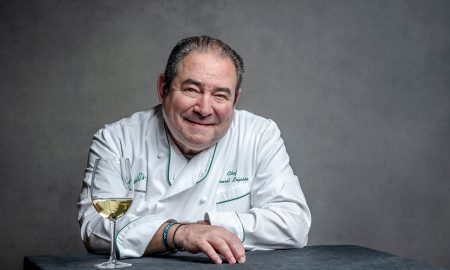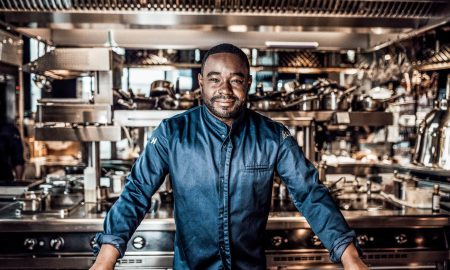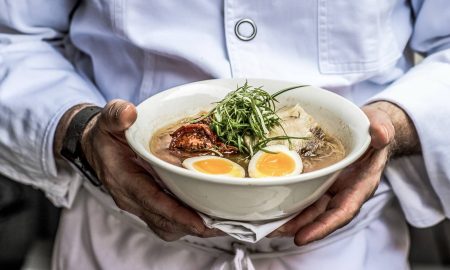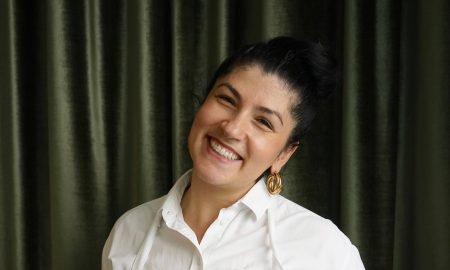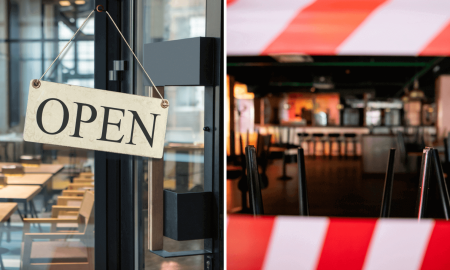Lots of skin, juicy thighs and wild, ecstatic fun until you drop. Indeed, what is true for Brazil’s legendary samba festivals is also the perfect description for Ivan Ralston’s dishes. Admittedly, the prodigy of top Brazilian cuisine creates these wonders in São Paulo rather than in the carnival metropolis Rio de Janeiro. However, the truth is, “Paulistanos” know how to celebrate this mega event with at least as much joie de vivre. Believe it not, it is even more colorful there than in Brazil’s secret capital.
“São Paulo is the most multicultural city I know,” says the 35-year-old, and he’s someone who should know. A well-travelled adventurer, he spent his formative years training and wandering around the USA, Spain and Japan. The fact that his grandparents, German-Austrian Jews, fled to Brazil during the Second World War adds to the story. It is exactly this historically evolved melange that Ivan Ralston impressively brings to the plate in his restaurant Tuju. In 2017, this earned him the coveted 45th spot on the prestigious Latin America’s 50 Best Restaurants list; he was awarded his second Michelin star the same year. But who exactly is this up-and-coming Brazilian culinary wonder? How does this unbridled creative force manage to get to the heart of his heritage in such a precise culinary fashion?
Ralston’s career began in a way that is not particularly uncommon. Although – or perhaps because? – his parents are restaurateurs, he decided to pursue a career path that had little in common with the culinary world when he started studying jazz at Berkeley College in Boston. “It lasted less than two years,” recalls Ralston, who did however manage to complete his bachelor’s degree during that time.
Feeling lost after he returned to São Paolo, he initially started working in the kitchen of his parents’ restaurant. “I knew right away that this is what I wanted to do for the rest of my life.” After three years working for his parents, he continued his training at Maní, one of the best restaurants in São Paulo. “At that time, it was difficult to become a really good chef just by working at different places in Brazil.” So he decided to go to Spain, where he made up for his lack of formal culinary training at the culinary school; in an attempt to quench his restless desire to learn, he worked at the legendary El Celler de Can Roca and the even more legendary Mugaritz. “What I learned there was amazing.”
The fact that the culinary riches of the Iberian Peninsula could not satisfy Ralston’s hunger for novelty was because of his boundless curiosity, which to this day instinctively looks beyond the horizon. “I always definitely wanted to go to Japan,” says the ex-jazz musician. To put things more precisely, Ralston not only honed his culinary chops working at none other than the three-Michelin-starred Ryugin gourmet temple in Tokyo, he also enhanced his understanding for different gastro cultures. “The differences between Spanish and Japanese star cuisine are mind-boggling,” Ralston notes. “I was used to the Spanish 3-star kitchens, they’re all about three times bigger! But in Japan, it’s the complete opposite. The kitchen at Ryugin is barely 161 square feet (15 square meters). To be honest, I find the Japanese approach more realistic. Whether a restaurant has stars or not, it still has to function as a business.
Blessing and curse of the stars
Which brings us to Ralston’s own gourmet temple. Following his six-month stint in Tokyo, the globetrotting chef returned to his hometown where he opened Tuju in 2014. “I have two business partners, in other words, no investors. Things are going well, but of course, none of us are rich,” says the Neo-gastronome. Originally, Tuju featured a casual concept that reinterpreted traditional Brazilian cuisine. “But then after just six months, I was suddenly awarded a star. When the Michelin Guide called me to tell me this, I was sure someone was messing with me. So I said, “F*k you!” and hung up. But the prestigious macaron couldn’t have been more real, something Ralston himself came to feel in the years that followed. He suddenly become far too obsessively singled-minded in working on both himself and his kitchen, until he realized that cooking is about more than reaching for the stars. “It was strange. It was precisely because of this decision to relax that I finally got the second star,” recalls the man who has become so accustomed to success. Just a few minutes later, the amuse-bouches prove why these creations are worth two stars in the famous scarlet kitchen bible.
Sieh dir diesen Beitrag auf Instagram an
Apropos the “lots of skin” we mentioned at the beginning, we have to mention the small morsel made up of Langoustine, avocado and chicken skin. This delight combines the freshness of the Atlantic Ocean with the full, hearty traditional flavors of Brazil, as does Koji Tartelette, which is made of zucchini and caviar. That Ralston manages an equally complex array of flavors with a vegetarian dish clearly demonstrates his mastery. The dish brings artichokes, peas, green tomatoes and young parmesan together, a combination that makes the palate rejoice in every possible way. The surprisingly firm artichokes captivate with brilliant acidity, while the Parmesan cheese stirred into the sauce effectively absorbs exactly this tartness. The green tomatoes and peas immediately burst onto the flavor scene, providing a hefty dose of freshness.
Another highlight is without a doubt the dish featuring octopus, heart of palm, lardo and olive pesto. For this dish, the octopus is massaged for a full hour, then cooked in the steamer for four hours; afterwards, it blends perfectly with the full-bodied lardo and olive pesto. The heart of palm – a traditional product of São Paulo – is the secret ingredient that beautifully and unexpectedly breaks up the heaviness of this dish. With all its subtleties and quirks, even one of the most quintessential dishes from Ralston’s hometown looks – and tastes! – as if it has been on the menu for decades. Grouper, banana, curry and sweet potato is without a doubt one of the heartiest dishes of the evening. Something we found especially refreshing was Ralston’s uninhibited reinterpretation of the culinary heritage of his homeland. “Of course, there are also pigeon breeders in Brazil,” he says as he slyly explains the dish Bresse pigeon, tucup and beet. “Still, pigeon is and remains pretty damn French for me. But, in all seriousness, let me say that I simply love it.” Ralston is all the more playful by pairing the pigeon leg with tucupi – that is, the sauce made from bitter manioc juice so typical of northern Brazil – which is placed under the pigeon meat and adds an unmistakably Brazilian touch to the dish with a bit of tongue-in-cheek.
“The truth is I don’t cook for the guest,” Ralston says confidently.”I cook for myself, because I love to cook and work with different products. I don’t know if the guest will like what I do, but I love what I do for them.” Ralston’s skills, however, deserve to be appreciated by international guests as well. In March 2020, shortly before the first Corona lockdown changed the entire world, the savvy Brazilian was a guest chef at the two-star Ikarus in Salzburg’s Hangar-7. March, of course, could not be under the banner of the culinary cosmopolitan; however, this certainly makes it clear that the unique guest chef concept under the patronage of Chef of the Century Eckart Witzigmann and the leadership of Executive Chef Martin Klein has an undeniable instinct for the masters of the guild. No matter where we are now and wherever Ivan Ralston might be cooking in the future, with his culinary art, he proves that Brazilian top cuisine is unfairly overshadowed by Peruvian and Chilean cuisine, which have been so prominent in the media.










